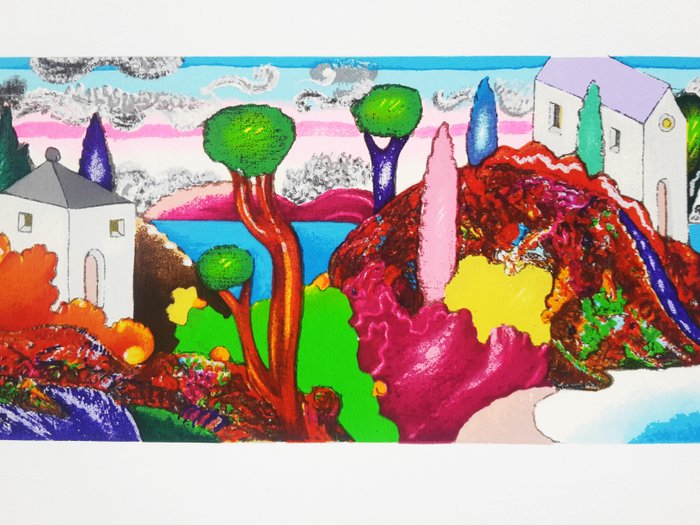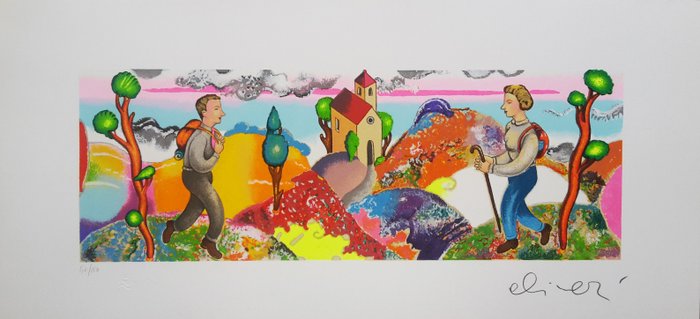Advert Description
Are you interested in this item? This item is up for auction at Catawiki. Please click on "respond to advert" (orange button) to get redirected to the Catawiki website. Catawiki’s goal is to make special objects universally available. Our weekly auctions feature thousands of unusual, rare, and exceptional objects you won’t find in just any store. LUCA ALINARI
‘Alla stessa ora ma in un cosmo analogo’
2 silk-screen prints
Textured silk-screen print
Sheet size: 33x70 cm
Edition: 150 Arabic numerals
Works signed and numbered by the artist
Publisher: La Riva art gallery
Professional packaging and shipping via SDA express courier.
Artist’s biography:
Luca Alinari was born on 27 October 1943 in Florence. Since he was a child he loved art and he used to draw and to paint. In 1972 he got a scholarship for young artists by the municipality of Florence.
Some years later he graduated in Arts and Philosophy. After that, he devoted himself mainly to literary criticism, becoming editor of art magazines and more. He never abandoned his painting, at which he worked while working as a journalist and critic.
In 1968 he participated in his first solo exhibition in Florence at the gallery Inquadrature. In his artistic production, Luca Alinari experimented with every kind of technique:
he switched from fresco to plexiglass, he used fabrics, wood and glass. His name became known to the public and critics after the mid-1970s, when Luca Alinari began to participate in major exhibitions in the most important galleries in Italy. In the 1980s he approached for the first time to the production of fantastical and imaginary landscapes, to which he still devotes himself today. His works don’t lack in irony, a sort of ironic criticism. The fantastical spacing, which is expressed through play, leads him to another possible reality where everything is animate. In the fantastical world of Luca Alinari there is a strong animism component. This artist is also very able to raise doubts, because his painting is intriguing and invites you to get involved in the fantasy story. A fable-like note is typical of his artistic and seductive fiction.
Alinari’s stories were a mental operation at the beginning of the 1970s, with a play on overlapping references and multiple connections, various quotations and crossed quotations in the thickness of his images, full of multiple reasons and disturbing ambiguities. In the 1980s his stories changed. Human figures appeared in his works, together with fragments of objects, of signs between the mechanical, the decorative and the cabalistic. Ambiguity was no longer represented by a single figure, but by a variety of presences flowing into space, freeing surprising allusions and illusions, collapsing in an subtly ironic imaginary world. Alinari’s painting is narrative, and his narration is all-round: every square centimetre of the work is the place for a metamorphosis where form and colour reproduce almost by parthenogenesis, giving rise to new drawings and new colours. In Alinari’s painting there is fairy-tale as well as an aggressive trend. The figures in his works sometimes seem to overlap and attack, elbowing their way and screaming. The space in Alinari’s works can be divided into segments, each one forming a new image within the same work. The artwork is a continuous work in progress, where each addendum calls new addenda. The images proposed by Alinari are reproductions of memory, ghosts, mirages, for this reason Alinari’s representation concerns the unreal. His are not views, but visions. In short, Alinari's painting (both when it proceeds by way of laying and when it works by way of raising, and when its declinations are more fabulous than when they are more elliptical) indicates that saying if it is really such is composed of two parts. The first consists of what is said, the second of everything else.
Luca Alinari was invited to the most important artistic events: in 1982 he participated in ‘Arti Visive '82’’, at the Venice Biennale; in 1986 he participated in the XI Rome Quadriennale.
Since 1989 his name has been praised by critics and public thanks to his participation in exhibitions in very prestigious places, such as: Palazzo Lanfranchi in Matera, gallery Fogola in Turin, Palazzo Reale in Milan, Casa del Masaccio in Valdarno, the Museum of Contemporary Art in Villa Croce in Genoa, the Tour Fromage in Aosta, the gallery Il Bisonte in Florence. A detailed illustration of his artistic and cultural career was given in 1993 by the anthological exhibition curated by E. Crispolti at the Arengo of Milan.
In 1990 he painted ‘Il Cencio’ for the Palio di Siena.
In 1999 one of his self-portraits was acquired by the Uffizi Gallery.
Luca Alinari also devoted himself to graphic design with great emphasis and success, creating a series of original works for the use of materials and sizes, using especially the techniques of serigraphy and lithography.
Luca Alinari died in 2019 in Florence. 67646555





